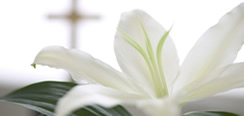
Easter is the time of springtime festivals, a time to welcome back the Tulips, the Crocuses and the Daffodils.
Happy Easter
Easter and the holidays that are related to it are moveable feasts, in that they do not fall on a fixed date in the Gregorian or Julian calendars (both of which follow the cycle of the sun and the seasons). Instead, the date for Easter is determined on a lunisolar calendar, as is the Hebrew calendar.
As with many other Christian dates, the celebration of Easter extends beyond the church. Since its origins, it has been a time of celebration and feasting and many traditional Easter games and customs developed, such as Egg rolling, Egg tapping and Egg decorating.

- The Easter Story as told in the GospelsFor God so loved the world, that he gave his only begotten Son, that whosoever believeth in him should not perish, but have everlasting life. For God sent not his Son into the world to condemn the world; but that the world through him might be saved. (John 3:16-17)
- The History of EasterThe word "Oestre" and it's variations was the old Teutonic word for dawn/sunrise. This word is one of the roots of our word "east", and also the name of the female hormone "oestrogen".
- The word "Easter" in other languagesEaster derived from the goddess Eastre or from Eostremonat.
- Why Do We Give Easter Eggs?Given as gifts by the ancient Greeks, Persians, and Chinese at their spring festivals, the egg also appears in pagan mythology, where we read of the Sun-Bird being hatched from the World Egg.
- Easter BunnyThe idea of an egg laying rabbit came to the United States in the 1700s.





Facts About Easter
- In most languages other than English and German, the holiday's name is derived from Pesach, the Hebrew name of Passover.
- The traditional act of painting eggs is called Pysanka.
- The Cross is the symbol of the Crucifixion, as opposed to the Resurrection.
- The resurrection of Jesus took place during the Passover.
- The Passover is the 8 day observance commemorating the freedom and exodus of the Israelites (Jewish slaves) from Egypt during the reign of the Pharaoh Ramses II.
- 16 billion jelly beans are made for Easter.
- The first chocolate eggs were made in Europe in the early 19th century and remain among the most popular treats associated with Easter.
- 90 million chocolate Easter bunnies are made for Easter each year.
- The first Easter baskets were made to look like bird's nests.
- Each day, five million marshmallow chicks and bunnies are produced in preparation for Easter.
- Easter is the second top-selling confectionery holiday behind only Halloween.
- 76 percent of people eat the ears on chocolate bunnies first.
- Red jelly beans are kids' favorite.
Did you know that?
- Easter is named after Eastre, an Anglo-Saxon goddess! Her symbols were the hare and the egg.
- From the earliest times, the egg was a symbol of rebirth in most cultures.
- EASTER never occurs before March 22nd, or after April 25th.

- Easter (also called Pascha)
- Easter Eggs Traditions
- Easter Party Ideas
- Non-religious Easter Traditions
- Peter Cottontail
- Eggs-travagant Eggs
- Easter Bonnet
- Easter Link: Easter.dvdesign.com
- Send an Easter E-Card
- Other Holidays on the InfoStarBase
More Easter History
largest Easter egg
According to the Guinness Book of World Records the largest Easter egg ever made was just over 25-ft high and made of chocolate and marshmallow. The egg weighed 8,968 lbs. and was supported by an internal steel frame.
Source: Guinness Book of World Records

